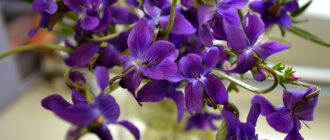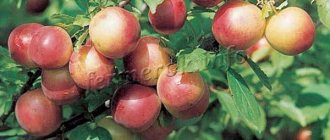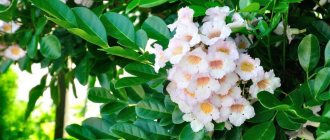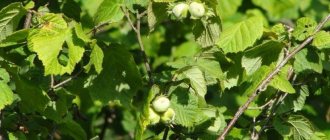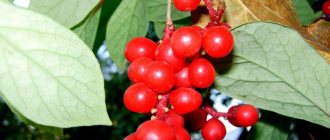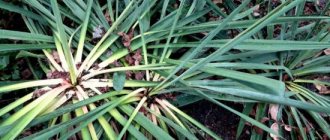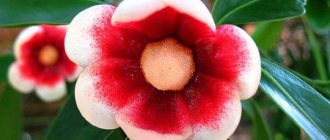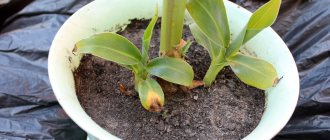2.Description - what it looks like
Perennial herbaceous plants with thick, creeping rhizomes covered with brown scales.
Lungwort has erect, pubescent shoots, on which soft, fluffy, green leaves are alternately located.
The structure and size of the leaves will be different depending on the height - the lower the leaf blades are located, the longer their petioles, the upper leaves are sessile. The dimensions of the leaf plates decrease towards the tops of the shoots; if the lower ones can reach a length of 60 cm, then the length of the upper ones often does not exceed 5 cm.
At the tops of the stems there are small inflorescences with purple, fluffy buds. Often, after flowering, a leaf rosette forms at the base of the flower.
↑ Up,
The flowers are bell-shaped, with fused petals, pink, red, blue or purple, reaching a diameter of 2 - 3 cm, collected in unique inflorescences - paired apical curls. The buds are male and female, and plants require cross-pollination to form seeds.
A distinctive feature of plants is that the same inflorescence can contain flowers of different shades, which will depend on the acidity level of the plant juice. Only the blossoming buds can be colored pink (they contain more acidic juice), but as they fade they will turn blue.
After flowering, green boxes with small black, glossy seeds are formed.
The plant is used both as a flowering plant and as an ornamental foliage plant, since many modern varieties have attractive variegated leaves with white spots and streaks on the surface.
The genus Lungwort includes about 15 plant species.
↑ Up,
Height . Depending on the specific species and growing conditions, plants can reach a height of 10 - 80 cm.
General description of the plant
Pulmonaria is the second name of the plant. Belongs to the Burachnikov family. The plant has a straight, downy stem, up to 30 centimeters in height. The leaf is basal, long-petiolate, velvety. It has an elliptical shape, with a pointed end.
Flowering begins as soon as the snow melts and continues until May. An inflorescence with small flowers, collected in a shield and located at the top of the stem. Flowering is not simultaneous. The young flower produces a pink bud, then begins to darken, up to lilac. Because of this feature, it turns out that the inflorescence contains flowers of different colors.
Bees love lungwort because it is a honey plant. Its young leaves are rich in potassium salts, calcium, iron, nickel; they are added to salads. Contains vitamin C, carotene and rutin. These elements will be preserved even when boiled, pickled and dried.
Interesting! In England, lungwort is grown in large quantities. Precisely because of its beneficial properties.
The appearance of the plant may vary slightly among different types of pulmonaria.
3.When it blooms
The flowering period begins in early spring, when many plants have not even acquired leaves yet. The first buds can open as early as April, late species bloom in May.
If flowering in the spring months was interrupted by the onset of intense heat, then a second wave of buds may appear in the autumn months.
Flowering in a well-lit place will be earlier but shorter lasting. When grown in partial shade, flowering will occur later, but will be longer, and the buds will be brighter.
↑ Up,
Decorative properties
This primrose, thanks to the color of the leaves and early flowers, looks great in group plantings of early flowers in flower beds. Naturally, this shrub appears among conifers, forming a dense carpet around them.
Lungwort is planted along the edge of borders; it frames them aesthetically. It is indispensable both in alpine hills and in group plantings of summer flowers: phlox, astilbe, daylilies. Looks very good in composition with hosta of various varieties.
Lungwort is a flower that tolerates shade well. It will decorate a shady corner where other flowers do not grow. And in the spring it will delight you with the first flowers. Its chic bush of bright leaves will be appropriate in any part of the garden.
4.Types of lungwort:
4.1. Lungwort - Pulmonaria officinalis
Plants of this species grow in Europe and are compact in size - the height of the bushes does not exceed 30 - 40 cm. The flowering period occurs at the end of April - beginning of May, the buds change their shade from pink to purple and then blue. Widely used in folk medicine.
↑ Up,
4.2. Sugar or white-spotted lungwort - Pulmonaria saccharata
A frost-resistant plant that, when grown in the garden, can tolerate frosts down to -20 degrees Celsius. This species is distinguished by the presence of attractive white specks on the leaf blades and on its basis many forms of variegated lungworts have been bred. The height of the plants is 45 - 60 cm, flowering occurs in April - May.
↑ Up,
4.3.Lungwort unclear, tender or dark - Pulmonaria obscura
Stocky, strong plants up to 30 cm high with very early flowering - often the buds bloom while there is still snow cover in places. The native habitat for this species is England.
↑ Up,
4.4. Soft, mountain or hairy lungwort - Pulmonaria mollis
One of the tallest varieties of lungwort - plants reach a height of 50 - 70 cm and are found in Central Europe and Asia. The species has excellent tolerance to low temperatures and exposure to direct sun.
↑ Up,
4.5. Narrow-leaved lungwort - Pulmanaria angustifolia
Compact flowering perennial 20 - 30 cm high with strong, vertical shoots and narrow, entire, green leaves. The buds are bright blue or light blue and decorate the plants in spring.
↑ Up,
4.6. Long-leaved lungwort - Pulmonaria longifolia
A Western European species 40–60 cm high with brightly colored dark green leaves, on the surface of which small white round spots are scattered. The peduncles are low, bearing large, blue or blue buds at the tops.
↑ Up,
How to use lungwort in landscape design
If your garden is decorated in a landscape or rustic style, then wild varieties of lungwort will come in very handy. They reproduce well on their own and will inhabit all the places that are comfortable for them without your participation. For a more regular garden, it is better to use specially bred ornamental varieties, planting them in groups in shady corners or placing them as a border along paths, provided that they pass under the canopy of trees and shrubs. Lungwort angustifolia will be appropriate on the northeastern slopes of alpine hills, and the softest one will be suitable for fairly brightly lit areas of the garden. The decorative foliage of lungwort looks great in mixborders, where hostas, ferns or uvularia are good candidates for it as partners. Blue flowers look good in plain spring flower beds next to forget-me-nots and periwinkles. The plant's spectacular leaves will be the perfect backdrop for bright phlox or daylilies.
0
Back
Annual wormwood and other species: photo
MORE
5. Varieties and hybrids of lungwort:
5.1. Hybrid lungwort Silver Bouquet
A distinctive feature of this variety is its compact size - the height of the plants does not exceed 25 cm and very attractive leaves with a spotted, white-silver surface. During the flowering period, the plants form low flower stalks with pink buds, which turn blue as they fade. The variety is very resistant to powdery mildew.
↑ Up,
5.2. Lungwort Cevennensis - Pulmonaria Cevennensis
The height of the bushes of this variety can reach 30 - 45 cm, and the leaves are painted in a dark green shade with contrasting white spots. The bright blue buds that appear in mid-spring complete the picture.
↑ Up,
5.3. Lungwort Majesty - Majeste
Flowering perennials, the main distinguishing feature of which is silvery, almost monochromatic, long leaves. The variety is compact in size = its bushes do not exceed 15 - 30 cm in height. The buds change their color from pink to blue.
↑ Up,
5.4.Lungwort Moonshine
Miniature plants 15 - 20 cm high with a very early flowering period. The leaves are dark green, quite wide, with a bright white center. The buds are initially painted pink, which changes to pale blue as they fade.
↑ Up,
5.5. Sugar lungwort Leopard - Leopard
It is unlikely that anyone will be left indifferent by the spectacular appearance of this flowering perennial - its bushes up to 20 - 30 cm high have delicate light green leaves with small, rounded white spots on the surface. During the flowering period, which occurs in April - May, the bushes are mainly decorated with pink buds.
↑ Up,
6. Planting and care
To grow a flower, you need a semi-shaded or even shady area of the garden - the lungwort does not like open sunny spaces - the flowering period in such conditions is significantly reduced, and the buds simply fade in the sun. Areas that receive morning sunlight will be preferable.
Since the development and flowering of lungwort occur in the early stages, the trunk circles of shrubs and trees can be used for its cultivation. At the time when lungwort is already blooming, most plants do not yet have leaves.
↑ Up,
If the flower is planted in a well-lit place, then timely watering will help it survive a large amount of sunlight.
In too acidic soil, plants will get sick and develop extremely slowly; flowering in such conditions is inhibited - soil levels close to neutral or slightly alkaline are preferred. Crushed chalk, eggshells, wood ash or a little slaked lime are mixed into the acidic soil before planting. The optimal pH level for a flower will be 7.0 - 7.5.
Plants also cannot tolerate high air temperatures; they should not be planted on the south side of buildings.
When choosing a location for lungwort, it is also worth considering its ability to spread through underground rhizomes or by self-seeding.
↑ Up,
6.1.How and when to plant
Planting seedlings in open ground is carried out in the spring - in May, when the threat of the return of night frosts is minimal. You can sow the seeds in early spring, but such plants will flower later.
Using seedlings, you can also plant lungwort at the beginning of autumn, so that the bushes have time to properly grow roots before the first night frosts.
It is better to postpone planting until the evening or in cloudy and cool weather. The soil is thoroughly loosened and weeds are removed from the site. Lungwort loves nutritious and well-drained soils that easily allow melt and rain moisture to pass through.
↑ Up,
To create soil of the desired structure, river sand is mixed into heavy soils, which prevents caking, and organic matter is added to the soil as additional nutrition - humus from a compost pit or well-rotted horse or cow manure. You can water the area with a weak solution of chicken droppings.
The composition of the soil for different species may differ, since in nature plants develop in different conditions. Thus, the angustifolia lungwort easily tolerates substrates with a high content of river sand and tolerates lack of nutrition, but does not tolerate stagnant moisture. Sugar lungwort can serve as a decoration for an alpine hill - it is easy to grow on a rocky slope with excellent drainage.
↑ Up,
Using a shovel, dig planting holes, the distance between which is maintained in accordance with the size of the plants. For low-growing lungworts, it is enough to leave 15 - 20 cm between the bushes, while for large specimens the distance between the holes should be 30 - 40 cm. A sufficiently large distance between the holes will be required for species such as L. officinalis, shaft-shaped and red.
The depth and height of the holes should be greater than the root ball of the seedlings or slightly larger. If the soil is heavy and retains moisture after rain, then additionally place a drainage layer in the form of river sand or small pebbles in each planting hole. The height of such a drainage layer can be 2 - 3 cm.
↑ Up,
Seedlings in cups are thoroughly watered a day before planting to soften the earthen lump. Planting is carried out using the transfer method - the bushes are taken out of cups or pots along with a lump of earth and carefully, trying not to destroy it, they are placed in the holes. The plants are sprinkled with soil in a circle and tamped down lightly with your fingertips.
You should not bury the flowers too deeply - after planting in open ground, they should remain at the same depth as they were in the pots.
Planted specimens are watered with warm water and the base is mulched with cut grass or straw. You can also use sawdust or small pieces of bark as mulch. The height of the mulch layer can reach 4 - 5 cm.
↑ Up,
Mulch may not be required when growing in partial shade - in such conditions, moisture evaporates from the surface of the earth much more slowly, and lungwort bushes have time to form a leaf rosette before the area is overgrown with weeds.
The flower does not like heavy fertilizing - 1 - 2 applications of fertilizers during the warm season are enough. The first feeding should be done when the first signs of new growth appear in the spring, the second - during flowering.
Both mineral and organic substances are used to feed lungworts. As mineral fertilizers, it is worth using complex liquid or granular fertilizers for flowering plants.
As an organic matter, the flower responds well to the use of well-rotted leaf or turf humus, as well as horse or cow manure.
The use of fresh organic matter is unacceptable - the plants will become weak, susceptible to fungal diseases, and flowering will become less abundant.
↑ Up,
6.2.Pruning, wintering
To maintain visual attractiveness and prevent the development and spread of diseases, it is worth monitoring plants and promptly removing fading flowers along with peduncles, as well as dying old leaves.
Timely removal of flower stalks prevents self-seeding and also saves the energy of plants, which do not need to spend it on forming seeds. Such specimens may re-bloom, which will occur in late summer - the first half of autumn.
Pruning is carried out using a sharpened and sterile instrument - pruning shears or a garden knife. In early spring, they also try to get rid of last year's dry leaves that have lost their attractiveness.
↑ Up,
Wintering in the conditions of the Middle Zone is usually quite easy for most species, but for the soft lungwort and the shaft-shaped lungwort it is worth making a shelter. Plants in regions where winters are quite severe and have little snow should also be protected.
At the end of autumn, when night temperatures drop below zero, the area with flowers is mulched with humus. For the above species and in the northern regions, plants provide additional insulation in the form of spruce branches, dry leaf litter or dry sawdust. The height of the insulating layer can reach 6 - 8 cm.
In early spring, as soon as the snow melts in this area, the insulation is removed. Shelter is also necessary for bushes planted in autumn.
↑ Up,
6.3.Transplant
If necessary, the lungwort can be transplanted to another place immediately after flowering or in September. During the period of bud formation, you should not move the flower. Transplantation can be combined with division if the flower is more than 4 - 5 years old.
If there is no need for division, then they try to transplant the plants together with the root ball without destroying it. Pre-prepare a planting hole that will exceed the bush's soil clod.
↑ Up,
For transshipment, the bushes are dug in a circle, going deep under the plants and removed, placing them on a piece of polyethylene. It will be convenient to transfer the flower on such material without shaking the soil.
Lungwort is planted in a new place at the same depth, after planting it is watered abundantly and covered from direct sun for 5-6 days.
↑ Up,
6.4.Water and fertilize
Lungwort loves fairly moist soil - make sure that the soil in the area with the flower never dries out. Particular care is taken to monitor soil moisture in newly planted, young plants and during the period when flower stalks form and flowering begins. After flowering, the frequency of watering is reduced.
The plants do not like moisture on the pubescent shoots and leaves - it is better to apply water from a watering can with a long spout directly under the root.
↑ Up,
Watering is carried out in the morning or evening - during the daytime, moisture will evaporate too quickly from the soil surface. In addition, if droplets of water and sunlight fall on the leaves of a flower, this can lead to sunburn.
Mature plants will easily tolerate short-term drought.
↑ Up,
Lungwort care
Caring for the plant is not difficult; even novice gardeners can follow the basic rules:
- Water regularly, avoiding waterlogging and drying out of the soil, especially during the formation of buds and flowering.
- If lungwort grows in partial shade, water less often than flowers in the sun.
- In sunny areas around the bush, it is better to mulch the soil, so the moisture will not evaporate very quickly.
- Remove weeds.
- Loosen the soil.
- Feed with mineral mixtures in the spring during leaf growth.
- In spring, remove last year's leaves.
- After flowering, get rid of flower stalks.
There is no need to remove leaves for the winter, only dry, old ones. In cold regions, cover the bushes with spruce branches, dry leaves, sawdust, and hay. Bushes are replanted every 4-5 years.
7. Reproduction
Both seed propagation of lungwort and cuttings using segments of rhizomes are possible. The flower propagates easily by seeds and often forms self-seeding, which can simply be transplanted from adult plants. Also, subject to certain agricultural techniques, vegetative propagation is also successful, in which the plants completely retain their appearance.
↑ Up,
7.1.Growing from seeds
Most modern garden varieties of lungwort are hybrids of several species, so when grown from seeds, the appearance of the daughter bushes can be strikingly different from the mother bushes.
It is not advisable to propagate varietal plants using seeds - this method of propagation is often used only by breeders. Only species-specific flowers retain their appearance completely.
In the garden, lungwort can actively spread by self-seeding, and bushes can appear in different, sometimes the most unexpected places. This is due to the fact that ants love ripe seeds. As soon as the inseminations spill out of the ripe seed pods, the insects try to drag them into the anthill.
↑ Up,
Sowing seeds can be done directly in the garden - at the end of April or beginning of May. Crops are not so afraid of slight night frosts, but seedlings like a large amount of melt water in the soil.
Sowing seeds for seedlings can be done at home in seedling boxes - at the end of February or beginning of March. In this way, by the time of planting in May, it will be possible to obtain strong plants.
For sowing, a drainage layer in the form of a small fraction of expanded clay, river pebbles or pieces of foam is placed on the bottom of boxes with drainage holes. The boxes are filled with nutritious soil, the surface of which is moistened with warm water using a spray bottle.
↑ Up,
The seeds are sown and the seedlings are covered with a layer of soil about 1 cm thick, then the soil surface is sprayed again.
The top of the seedling boxes is covered with transparent plastic film or covered with a plastic lid to create a greenhouse effect. The boxes are ventilated daily, and the cover is removed as soon as the first shoots appear.
When each bush can boast 2-3 true leaves, the seedlings are picked and planted in separate cups. A week after diving, the flowers are fed with nitrogen fertilizers in a very weak concentration.
↑ Up,
Before planting in the ground, in May, the seedling boxes are placed outside for several hours a day, hardening the seedlings. Such hardening can be carried out for 7 - 10 days with a constant increase in time spent in the fresh air.
The first buds will decorate plants obtained from seeds at the age of 2 - 3 years.
↑ Up,
7.2.Dividing bushes
The most common and easiest way to reproduce lungwort. Every 3 - 5 years the bushes are dug up and divided into several parts. This division promotes plant rejuvenation.
The bushes are shaken off from soil residues and the roots are inspected. If necessary, rotten and diseased areas are cut off, leaving only healthy tissue.
The wounds after such pruning are sprinkled with crushed charcoal or ash for drying and disinfection.
The rhizomes are divided into several parts so that the length of each is at least 8 - 10 cm. At least 1 renewal bud must remain in each part of the rhizome.
↑ Up,
8. Medicinal properties and contraindications
As a medicinal plant, the species of the same name is used - lungwort officinalis, as well as obscure and soft. Its young shoots and leaves are considered edible and can be used, for example, in salads.
The plant contains a large number of useful substances, so lungwort is widely used in folk medicine. Thus, plant juice contains certain alkaloids, anthocyanins, polyphenols, flavonoids, tannins, saponins and tannins, iron, vitamin A and ascorbic acid, as well as iodine, potassium and silicon.
↑ Up,
Due to such a rich composition, the flower is often added to formulations and herbal teas for the treatment of pulmonary diseases, and during colds, vitamin C helps support the body’s immunity.
Breast preparations based on lungwort quickly cure coughs, as they have an expectorant effect. The plant is believed to have anti-inflammatory, antibacterial and antiseptic properties and can stop bleeding.
The mucus contained in plants envelops the stomach and helps alleviate the condition of diseases of the gastrointestinal tract.
For diseases of the kidneys and bladder, the flower is used as a diuretic; it is also believed that medicinal raw materials based on lungwort have an antitumor effect.
↑ Up,
When fresh, the green mass is crushed and applied to wounds in the form of a paste, and is used for many skin diseases. Lungwort decoctions help remove toxins and carcinogens from the body.
Official medicine does not yet recognize the healing properties of the flower.
↑ Up,
Possible allergic reactions may be a contraindication to the use of this plant, and if the dosage is exceeded, side effects may occur, such as nausea and vomiting. Plants are used with caution for hypertension - it can constrict blood vessels and thicken the blood, thereby increasing blood pressure. The use of the plant is not permissible for people prone to constipation.
↑ Up,
The collection of plants used to treat various diseases is carried out during the period of the beginning of flowering - at this time, the above-ground part of the bush contains the highest concentration of useful substances.
The stems are cut with sharp pruning shears, leaving small stumps, tied into bundles with twine and hung upside down. Also, shoots and leaves can be spread out in a thin layer in a warm and constantly ventilated place.
Raw materials should not be exposed to direct sunlight during the drying process - they can destroy most useful compounds.
↑ Up,
Properly dried plants are crushed and collected in small paper bags or fabric bags and used as needed for 2 - 3 years.
If rhizomes are used as medicinal raw materials, their collection is postponed until autumn. The bushes are dug up and the rhizomes are cleared of soil residues, the roots are washed with running water and placed in a special dryer, where about 40 degrees Celsius is maintained. After complete drying, the rhizomes are crushed and stored in the same way as the green parts.
↑ Up,
Mr. Summer Resident recommends: Lungwort – medicine for the flowerbed
The lungwort on the site is not only a beautiful flower with decorative leaves, but also a medicine that has a wide spectrum of action and is used in the complex treatment of various diseases.
Procurement of raw materials
The flowering period or before the buds open is the time to collect medicinal herbs. The stems along with the flowers are cut off and dry vegetation is removed. Tie in bunches and hang dry in the shade. Still in the oven, strictly at +40 °C. Then they grind it into powder and pour it into bags made of fabric or paper. Store dry herbs in a dry, cool place.
Compound
The medicinal properties and contraindications of lungwort are determined by its components. The composition of the medicinal herb:
- anthocyanins;
- flavonoids;
- routine;
- binders;
- polyphenols;
- allantoin;
- carotene;
- alkaloids;
- vitamin C;
- mucus;
In addition: copper, manganese, iron, iodine, silicon, potassium, calcium, saponins, tannins.
Benefit
Lungwort relieves cold symptoms and has other unique properties:
- Improves the functioning of the heart muscle, normalizes intracranial pressure, thickens the blood, constricts blood vessels, and stops bleeding.
- Relieves inflammation and promotes mucus removal.
- Calms the nervous system.
- Softens the skin, improves the structure of hair and nails, and slows down aging.
- Liquefies and removes mucus.
- Strengthens the immune system.
- Removes waste, toxins, eliminates inflammation of the gastric mucosa.
- Prevents thrombosis.
- Prevents malignant neoplasms
Lungwort is indispensable for the treatment of the upper respiratory tract: inflammation of the bronchi, lungs as an expectorant and cough reliever, also for tracheitis and laryngitis. Stops bleeding, helps with skin pathologies. Effective for rinsing the mouth after tooth extraction.
Due to the content of silicic acid, the herb relieves inflammation of the gastric and intestinal mucosa. It alleviates the symptoms of female diseases, it is used to prevent heart attacks and strokes, for pathologies of the thyroid gland, male prostate problems, anorexia, dysentery, and hemorrhoids.
The medicinal plant helps remove stones from the bladder and is used in cosmetology, but you must first consult a doctor.
Traditional medicine offers many recipes for infusions, decoctions, and alcohol tinctures with lungwort. They drink tea during diarrhea, freshly squeezed juice with vodka for anemia and leukemia. Pathologies of the bladder and kidneys are treated with herbal tea.
Prepared from young leaves of medicinal herbs, unknown salads, soups. The British grow it specifically for cooking.
9. Diseases and pests
If you water too much or plant in constantly flooded areas, the plant may develop root rot.
At low air temperatures and high humidity, as well as in the case of too close growing, signs of powdery mildew may appear on the leaves.
Of the harmful insects, slugs and snails can attack the flower.
↑ Up,


